Report

Explore Bain’s latest Customer Loyalty in Banking insights.
Massive migration in sight
Delight customers, and costs will drop out. It might sound counterintuitive, but this approach can change the trajectory of profits for large, traditional retail banks that have been frustrated by the slow pace of taking out costs.
Consider the $11.4 billion annual opportunity for the 25 largest US banks. If these banks reached the level of mobile and online banking use of their counterparts in the Netherlands, they would improve their Net Promoter Score®—a key metric of customer loyalty—by an average of 12 percentage points, Bain & Company estimates. That’s because mobile interactions are far more likely to delight customers than interactions at branches or through contact centers. Dutch banks began to reconfigure their branch networks a decade ago, as the country’s strong broadband infrastructure and shift to cashless commerce enabled consumers to adopt mobile banking early on.
The payoff is not only customer loyalty, but reduced costs as well. Each mobile interaction incurs a variable cost of about 10 cents, a small fraction of the $4 cost of a teller or call-agent interaction. As interactions migrate to mobile, a bank needs fewer tellers and call-center agents. So the 25 US banks would save $11.4 billion annually in aggregate if customers’ branch and call-center use declined to the Dutch level, and the banks reduced headcount accordingly (see Figure 1).

In Search of Customers Who Love Their Bank
With banks facing increased competition from tech firms, our latest report examines how the banks can focus on what customers value most.
Loyalty thus points the way to profitable growth. Of course, earning loyalty is not easy. The locus of loyalty has shifted in recent years from friendly service at the branch to other attributes, especially simplicity and convenience. And those features depend largely on creating strong digital channels, then teaching customers how to use them.
This constitutes a sea change for banks, particularly for midsize or smaller regional banks that have relied on local knowledge and branch service to attract and keep customers. Top loyalty scores for an excellent branch experience miss the main point: Mobile channels have become the new way for busy consumers to do their banking. Banks that expect people to travel to the branch or wait in the queue for a phone agent for routine transactions are wasting people’s time.
Senior managers who understand this shift have a massive opportunity within their grasp, if they can wrangle their organizations to harness the mobile revolution. By accelerating the migration of customers from high-cost branches and contact centers to self-service mobile and online, they stand to reap a threefold payoff:
• They would earn greater customer loyalty by developing simple, digital channels that customers embrace.
• As more customers adopt digital, the level of routine or avoidable transactions in high-cost branches and call centers will go down. Subsequent staff reductions and reassignments to higher-value activities will lower variable costs.
• Banks can then close branches and increase digital sales, which expands profitability.
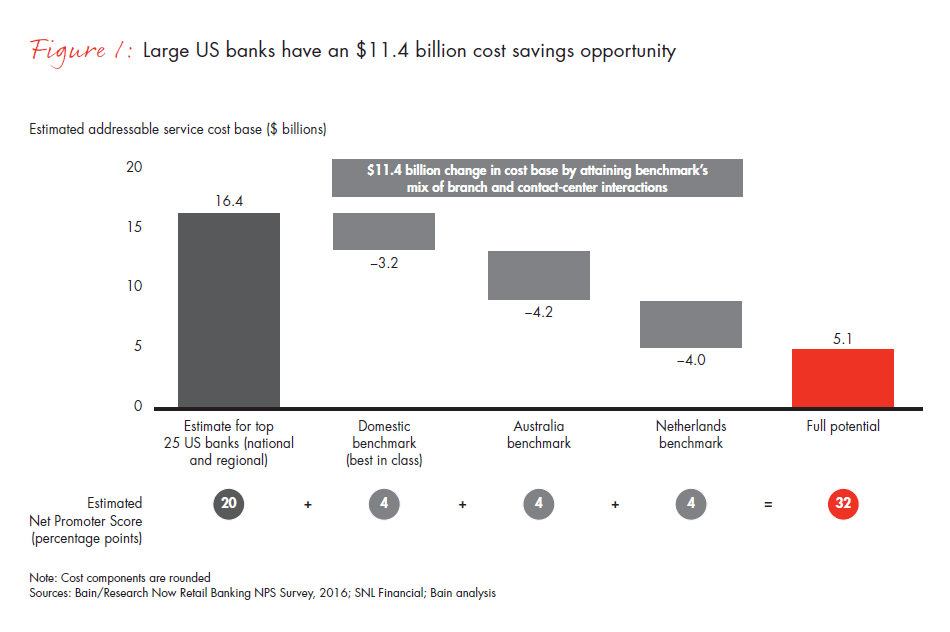
Realizing the fruits of the mobile revolution will require new management techniques. Most banks will have to become more aggressive and thoughtful about guiding customers to mobile self-service. Banks also must improve their mobile apps to make them truly easy and convenient. Bain’s new global survey of 137,034 consumers in 21 countries suggests where banks should focus their efforts, and practical ways to sequence that process.
Leaders make it simple and digital
Globally, direct banks continue to lead in Net Promoter Scores in most countries. These branchless institutions generally offer simpler product lines and streamlined operations, which appeal to many consumers who get overwhelmed by too much choice. Tangerine Bank, the loyalty leader in Canada, offers just one type of checking account online, compared with four to six at the major traditional banks. Some of the largest global and regional banks have borrowed a page from the playbook of direct banks, as they simplified products and improved their digital operations.
In the UK market, for example, Santander has steadily improved its relative Net Promoter Score over the past five years. The bank simplified its current-account product suite from about 100 to fewer than 10 products under the “123” branding, which refers to the mix of interest rates and cash-back rates. That simple proposition made it much easier for new customers to buy products and for bank agents to sell them. Critically, Santander migrated its entire back book of existing customers to the new system, even though the higher rates compressed its margins. (The bank recently reduced its interest rates, as the runaway success of 123, combined with record-low central bank rates, have made the program prohibitively costly to run in light of the new Brexit circumstances.) Santander also accelerated the development of its digital channels ahead of some other traditional banks, so that a customer now can refinance a mortgage online.
Smaller national or regional banks, by contrast, are getting squeezed in the middle. Many of them remain rooted in their branch experience and have not pushed as hard to build out their digital presence. Their past loyalty advantage that centered on the branch experience has waned.
One-third of banking customers have recently purchased a new product from a company that's not their primary bank. Gerard du Toit, a partner in Bain's Financial Services practice, explains how this "hidden defection" problem is making customer loyalty more important than ever.
Mobile growth starts to level off
For the first time in our annual survey, mobile growth has moderated, and in some countries appeared to be approaching the top of the classic S curve for technology diffusion. Transactions on smartphones and tablets, however, did continue to displace those on desktop and laptop computers, with nearly all countries now showing more mobile than online transactions.
Mobile adoption has been highest among the youngest consumers, but there is still ample room for growth among those in their 50s and older. Too often, this group has been overlooked by banks, which typically neglect to give older consumers guidance or even much information about the benefits of using mobile apps. (For a detailed analysis of US consumer behavior by age and transaction channel, see the Bain Brief “Bank Branch/Call Center Traffic Jam.”)
Despite the rise of mobile, high levels of routine transactions persist at branches and call centers. In the US, for instance, nearly 90% of respondents visited a teller during the previous quarter, and nearly half called their bank. A relatively small group of high-frequency customers create much of the traffic. Just 18% of respondents accounted for 58% of teller interactions, and 5% of respondents accounted for 39% of phone interactions. Digital channels often are not as effective as banks would like; many consumers trying these channels contended with various problems and wound up visiting a teller or calling a contact center anyway. When consumers failed in their attempts to transact digitally, more than one-third cited technical problems or lack of functionality.
Consumers who do not use bank mobile apps reported several reasons, notably habit, but also lack of knowledge and access issues. In addition, older users are slightly more dissuaded by habit and security concerns. Unless banks take an active role in addressing these issues, the pace of moving transactions from branches and call centers to digital channels—and the attendant cost reductions—will remain slow.
Do consumers resent branch closures?
As the shift to mobile banking progresses, most banks in most countries have begun to pare back their branch network. Both the extent of branch closures and the consequences for consumer loyalty vary greatly by market. Of survey respondents who experienced a nearby branch closure in the past year, 27% in the Netherlands and 54% in India said they completely switched banks or started using some products from a competitor (see Figure 2). Moreover, a branch closure caused Net Promoter Scores to drop by an average of 12 percentage points, and as much as 21 points in France, compared with the scores of respondents who did not experience a closure.
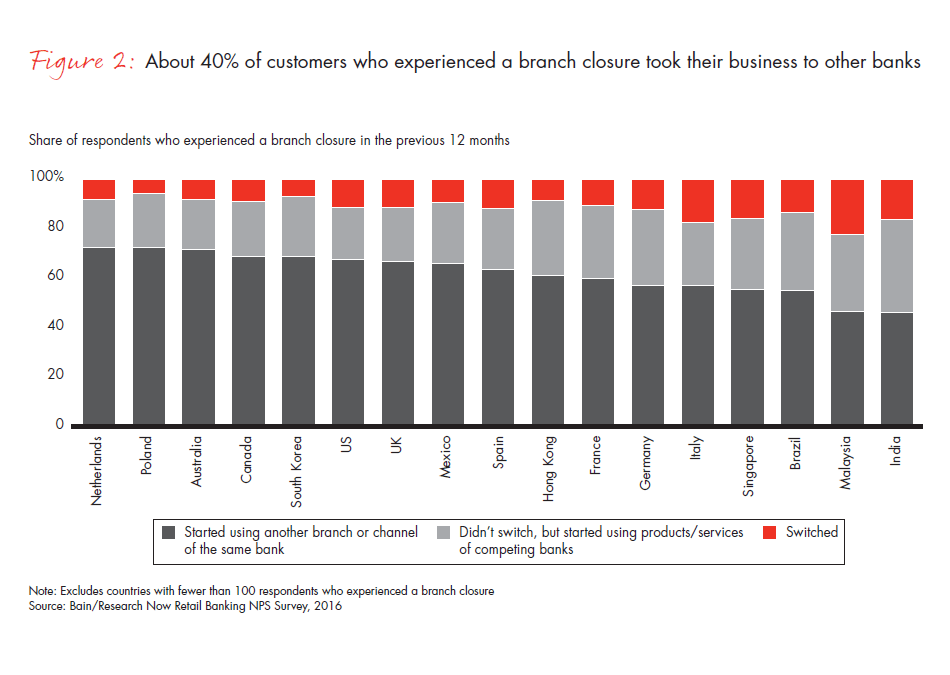
Here again, the Dutch experience is instructive for many countries. Dutch banks have not completely eliminated brick and mortar, but rather changed the nature of the branch. ING has side counters in bookstores and tobacco shops, while SNS has franchise arrangements with insurance agents and others. Most customers in this densely populated country thus still have access to a banker in walking or biking distance, but in a streamlined, low-cost format. So while many Dutch respondents said they have experienced a branch closure, relatively few switched banks or gave a lower Net Promoter Score as a result.
Given that many consumers still use a branch—60% of UK respondents visited one during the previous quarter—it would be dangerous to make large cuts to the brick-and-mortar network until customers find it easy to handle routine transactions through self-service digital channels. Banks can accelerate customers’ transition to digital channels, and planning for a new branch network should occur now, as it can take three to five years to reconfigure the network.
Related article: Why Closing Bank Branches Isn't Always a Road to Riches (WSJ.com)
Hidden defection is rampant
Many consumers—about 29% globally on average—said they would switch their primary bank if it were easy to do so. And hidden defection—purchasing a new banking product from a competing bank or financial technology firm—is taking place everywhere. It’s most pronounced in developing markets, where fewer consumers have long-standing relationships with an institution.
When the ball is up for grabs, a primary bank wins 64% of all purchases on average. But look at what walks out the door: Credit cards, loans, insurance and investments are the most purchased categories at competitors, whereas the primary bank tends to get a higher share of new, low-value deposit accounts (see Figure 3). The primary bank win rate for loans is just 57% vs. 78% for deposits. The stakes are high, as a 5-point increase in the overall win rate represents about $5 billion in revenue across the 25 largest US banks, we estimate.
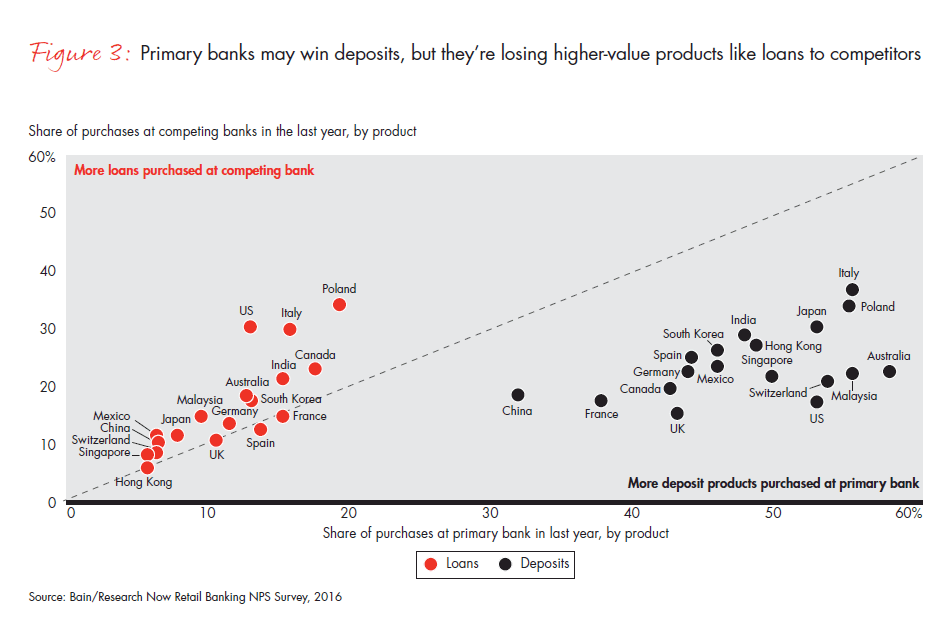
Direct banks and fintechs are taking a substantial share of new purchases on the strength of their relatively simple product lines and streamlined user experience, and appear to be well-positioned to continue expanding their share. Consumer purchases of additional banking products through digital channels, especially online, have become common and should increase as the ranks of younger, plugged-in generations swell.
Established technology companies with powerful brands and huge customer bases also are poised to move into such banking realms as consumer lending. For example, Apple offers leasing of its iPhones, and WeChat offers instant lending in China. In fact, developments in China may provide a glimpse of the future. Our survey respondents in China actually reported lower mobile usage for routine banking interactions this year, probably because consumers increasingly use more convenient and engaging non-bank platforms such as WeChat and Alipay for payments, savings and other daily financial transactions (see Figure 4). We expect these and other major tech firms to wedge their way further onto banks’ traditional turf.
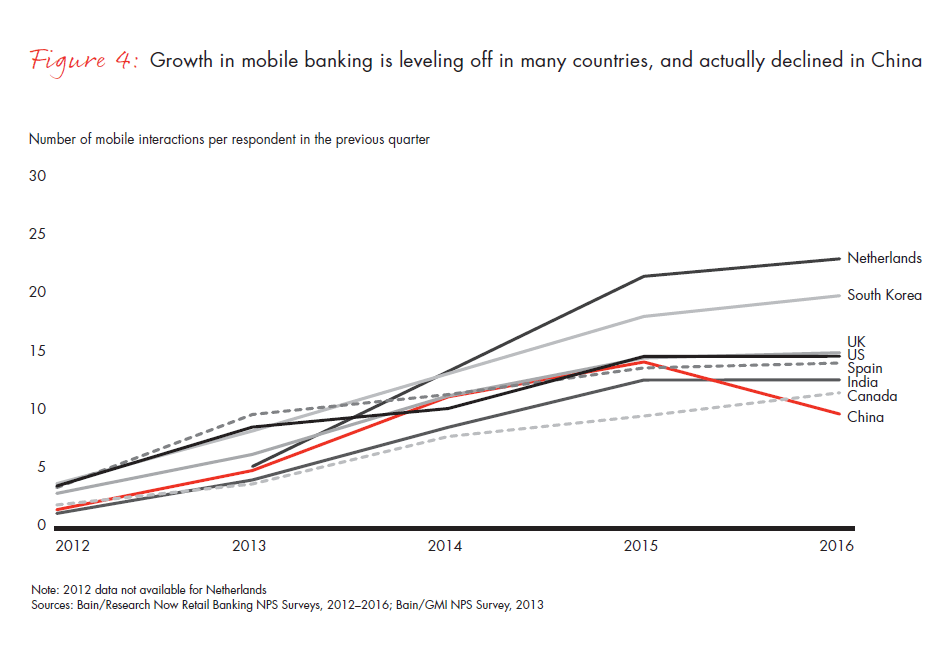
For banks looking to stem the tide of hidden defections, our analysis of the survey data shows where they should focus. Based on the variables in the survey, purchases from a competitor are most likely when the consumer owns multiple products at a primary bank, gives a low Net Promoter Score and is older. Of course, other elements also explain defections, such as exceptional products, pricing and salesmanship at the winning competitors. Still, there are no shortcuts to organic growth, especially with regulators’ heightened scrutiny of cross-selling practices and their desire for banks to focus on high-quality advice and service over sales. Sustained organic growth hinges on earning the right to sell customers another product. Nationwide Building Society in the UK, for instance, ranks as the loyalty leader among traditional banks and has above-average win rates for product purchases.
The path to digital adoption
For banks that have decent mobile apps, yet still lag in migrating customers to digital, the way forward is clear.
First, they should step up efforts to encourage mobile adoption and move routine transactions out of the branch and call center. Many older consumers require active guidance and information from banks about using mobile apps. Younger people present a separate challenge, mostly involving the basics of banking. They are still navigating how to pay bills, deposit checks, transfer money and generally resolve issues with their accounts—and they generate more interactions in the process. In China, respondents age 18–24 make almost twice the number of banking interactions on average as those age 65 or older. If young consumers don’t know how long it takes for a balance to update after a transaction, they will be more apt to phone the call center several times. Younger respondents also say they find digital channels confusing or inadequate for their banking, and often need help.
Banks should continue to streamline the experience of using both mobile or online channels, so that consumers turn to those channels before the branch or contact center. That will require designing simple and easy apps. Here, banks can take a cue from other industries, such as online retailers that send consumers a “Your purchase has shipped; click here to track” confirmation email. Improving the digital experience also entails eliminating bank policies or processes that impede convenience and reliability.
Once banks have accelerated mobile adoption and improved the digital banking experience, they can turn to building new functions for consumers to research and purchase products.

Why Do the Customers Keep Calling?
From millennials to seniors, banking customers still call and visit their banks a lot. Here is how banks can cut costs and delight customers while migrating them to mobile.
Organizing for simple and digital
Understanding the nature of this once-in-a-generation opportunity for digital migration is fairly straightforward. The bigger challenge lies in organizing the migration and instilling changes at the front line and back office in order to greatly improve how consumers do their banking.
Established banks tend to organize around functional silos, such as operations, compliance, IT and contact centers, along with their associated metrics. That legacy, combined with traditional process thinking, creates a powerful paradigm that makes it hard for the organization to see banking through its customers’ eyes and act accordingly.
But a few banks are making real progress toward a simple and digital experience—meaning fast, lean, automated and right the first time—by organizing around episodes rather than functional silos. From a customer’s perspective, the entire episode of buying a home and mortgage or resolving card fraud matters more than any single interaction along the way. Episodes tend to cut across many functions and departments. So organizing and managing directly around episodes is essential for succeeding with digital adoption and thereby earning greater loyalty from customers.
1. Mobile banking ekes out gains, but branch and phone use persists
- Mobile banking now exceeds online banking among consumers in most countries, with Sweden, South Korea, the Netherlands and Australia leading the way. But the previous torrid pace of mobile growth slowed in 2016.
- Yet banks still have a major opportunity to encourage older customers to adopt mobile, as seniors’ mobile use is well below that of young customers in every country.
- Routine interactions such as checking a balance or making a deposit have been slowly declining at branches. Levels of call-center use, however, persist and even tipped slightly higher in some countries. The Netherlands, where mobile banking took off early, has very low branch and phone use, and has experienced the greatest decline globally in commercial bank branches per capita.
- A small group of heavy users drives much of the branch and phone activity in every country. Brazil and Mexico have the highest share of heavy users.
- Besides the Netherlands, banks in a few other countries have made the greatest progress toward digital self-service by customers: Sweden, Poland and Australia. By contrast, Mexico, China, Hong Kong and India are the most branch-dependent markets.
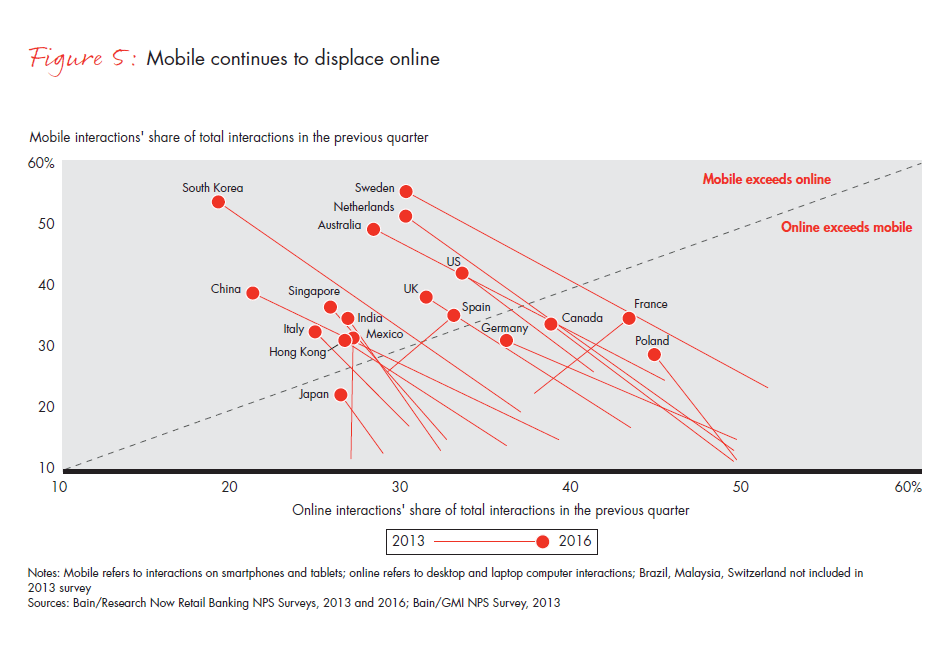
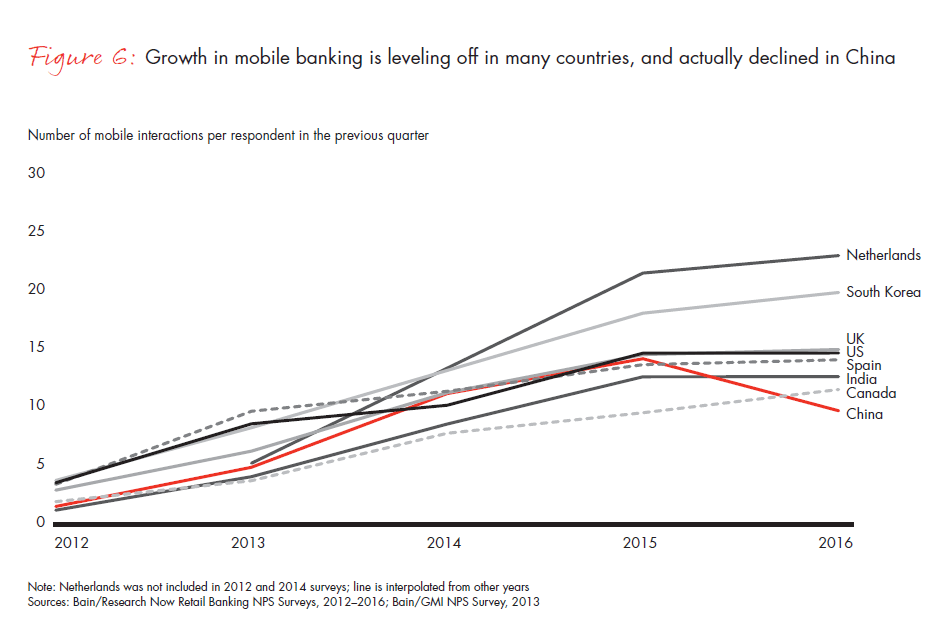
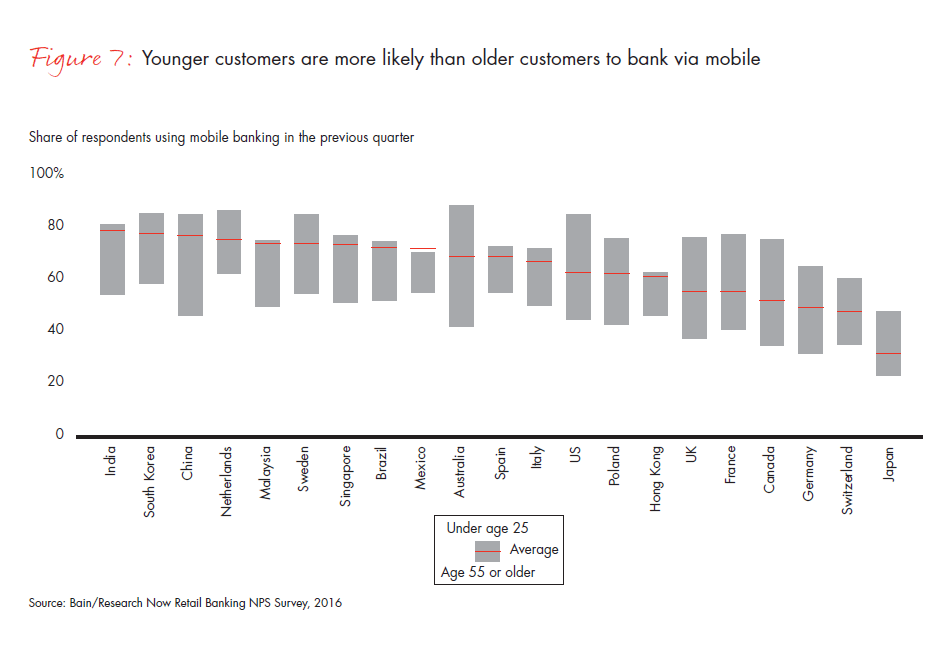
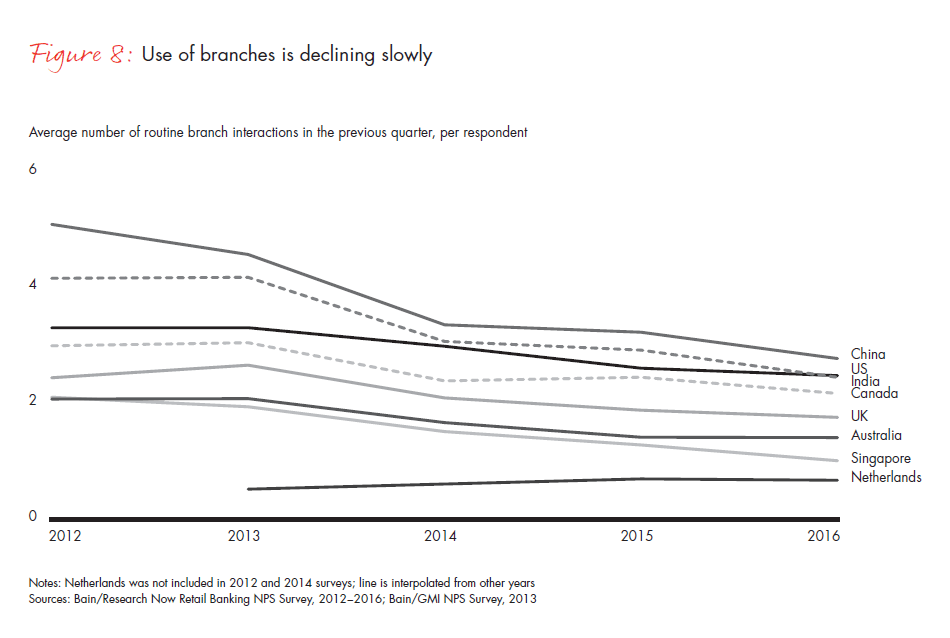
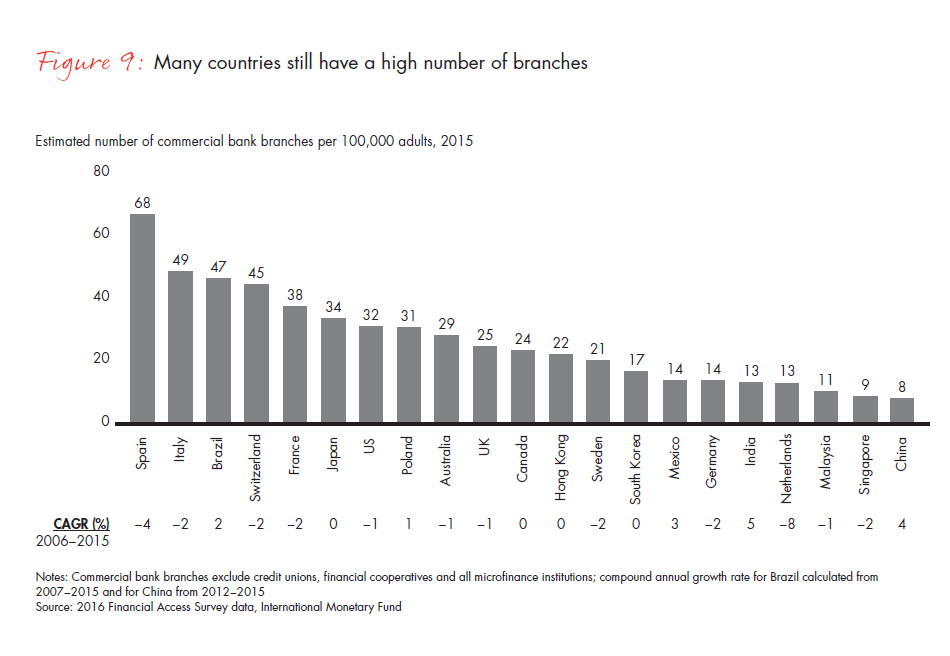
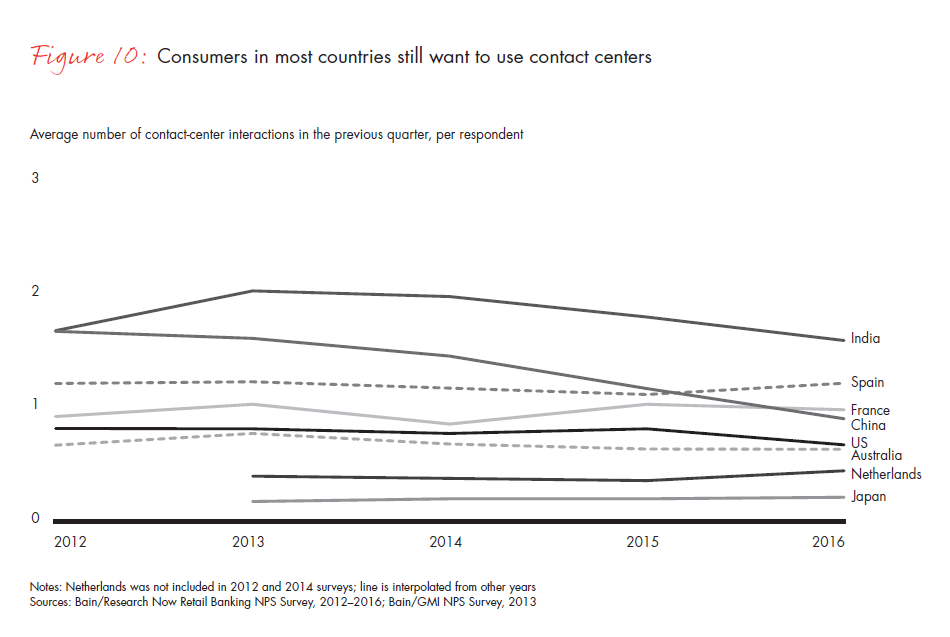
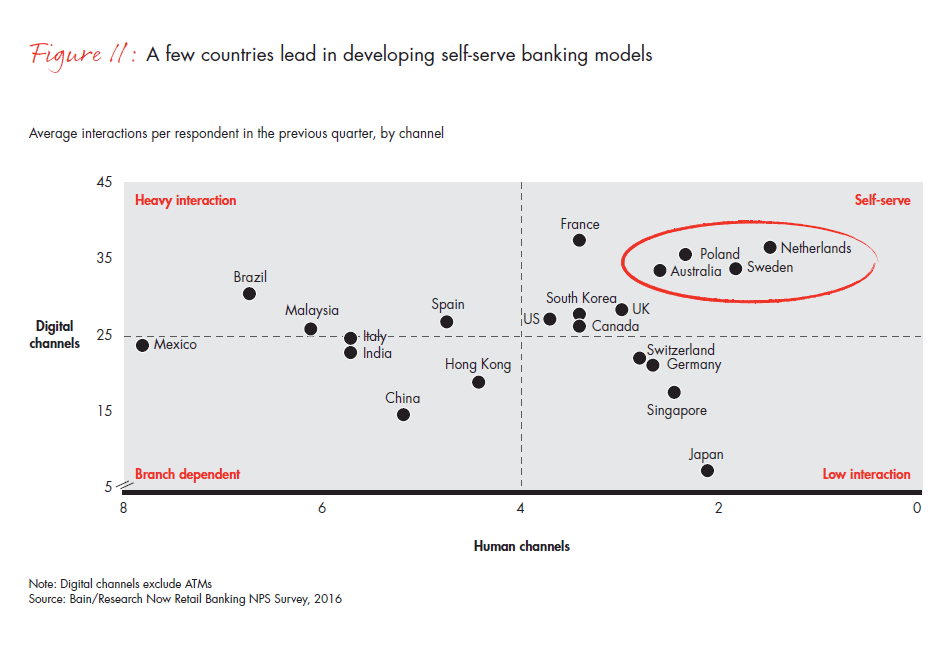
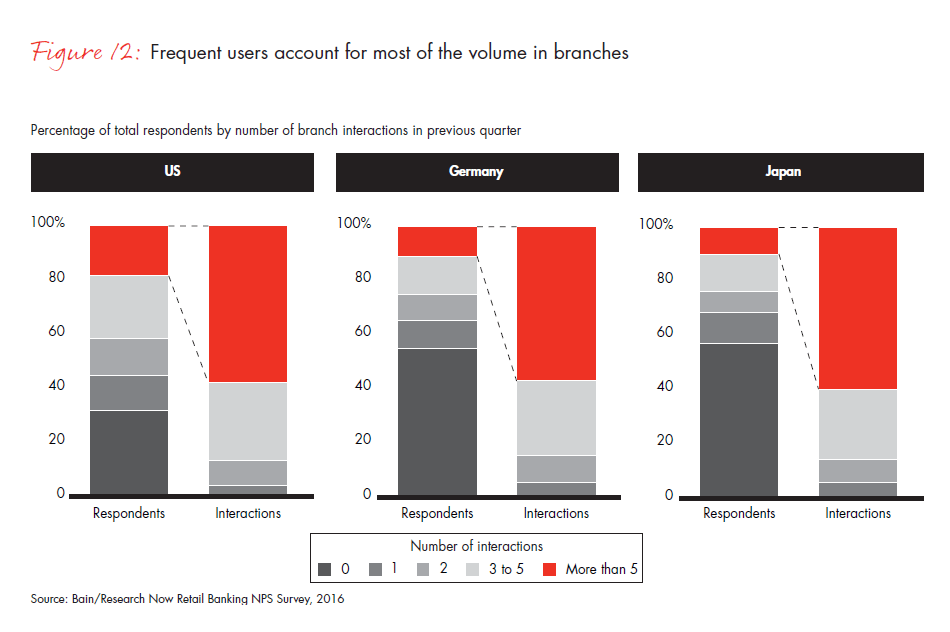
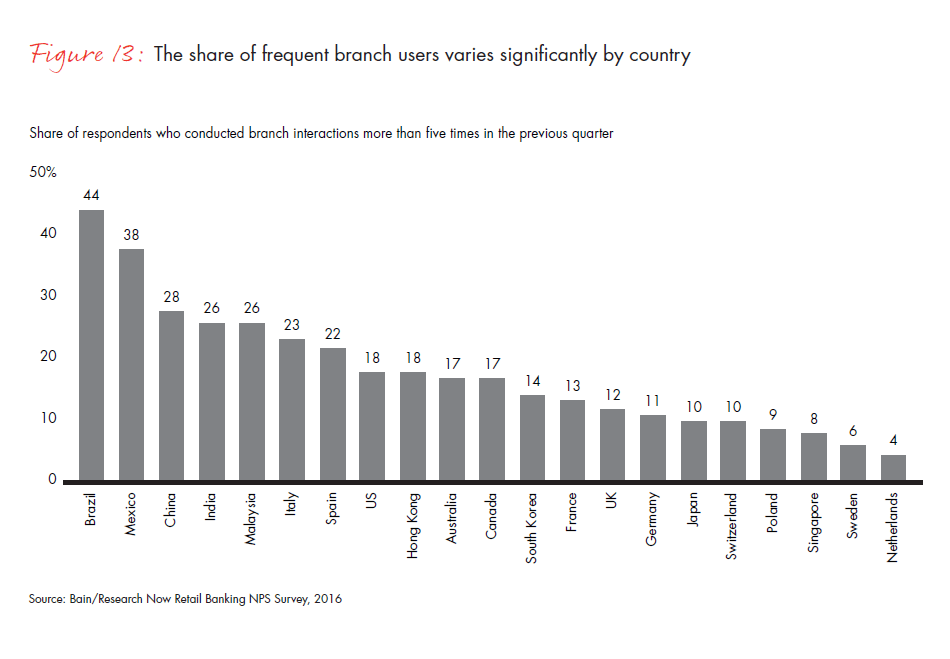
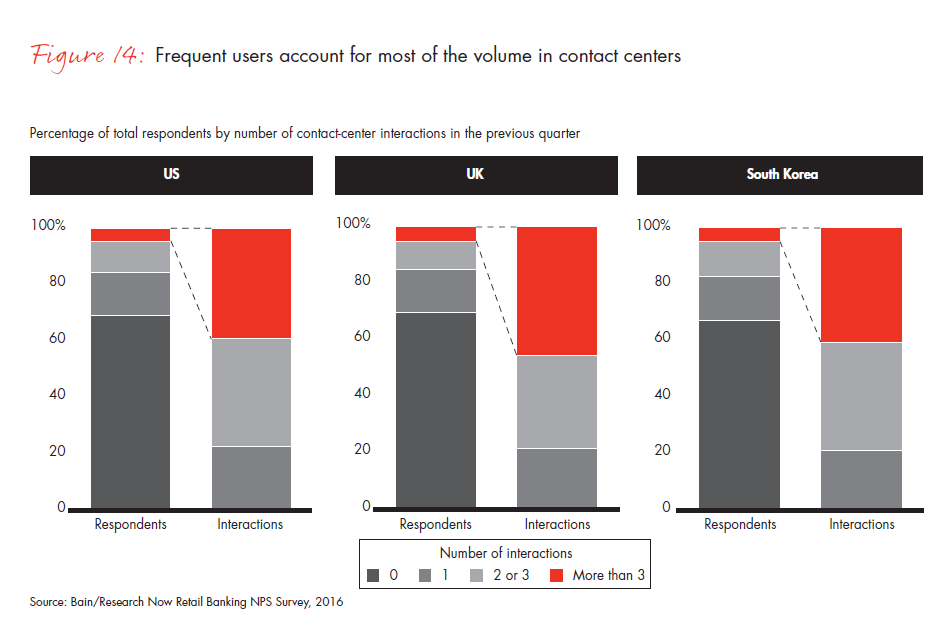
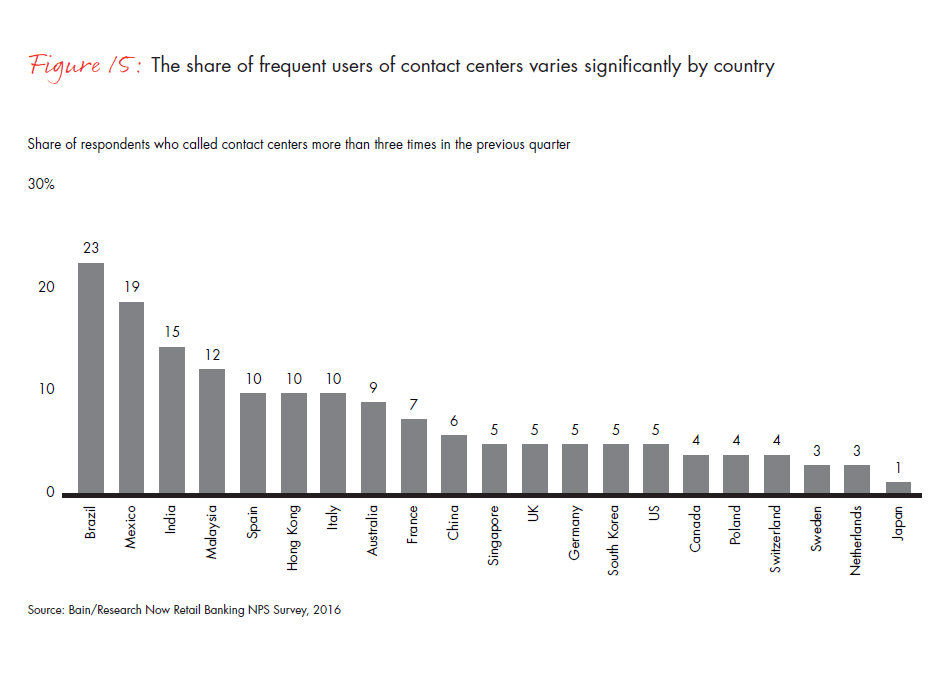
2. How branch closures affect consumers
- A significant share of consumers experienced a nearby branch closure. Spain, which experienced a wave of consolidation, had the highest share of respondents reporting a closure, at 17%. Next were India, where the government recently relaxed regulations on urban branch closure, and the Netherlands and the UK. Japan and China had the lowest shares, at 1% and 2%, respectively.
- Branch closures affect consumer behavior and perceptions. Roughly 40% of respondents globally reported that they switched their primary bank or started using other institutions for purchases of new banking products after they experienced a bank closure. India and Malaysia had the greatest share of such behavior; the Netherlands and Poland had the least.
- Closures correlate with lower loyalty scores in every country surveyed, but the effect varies substantially. Banks in France, Germany, Canada and South Korea suffered the sharpest drop in Net Promoter Scores after closures. Those in Singapore and India had only a slight decline associated with closures.
- Closures can have ripple effects, depending on how a bank handles the transition. Consumers who experienced a closure said they are 3 percentage points more likely in Australia and 24 points more likely in India to switch their primary bank in the future. Globally, the gap averaged 11 points.
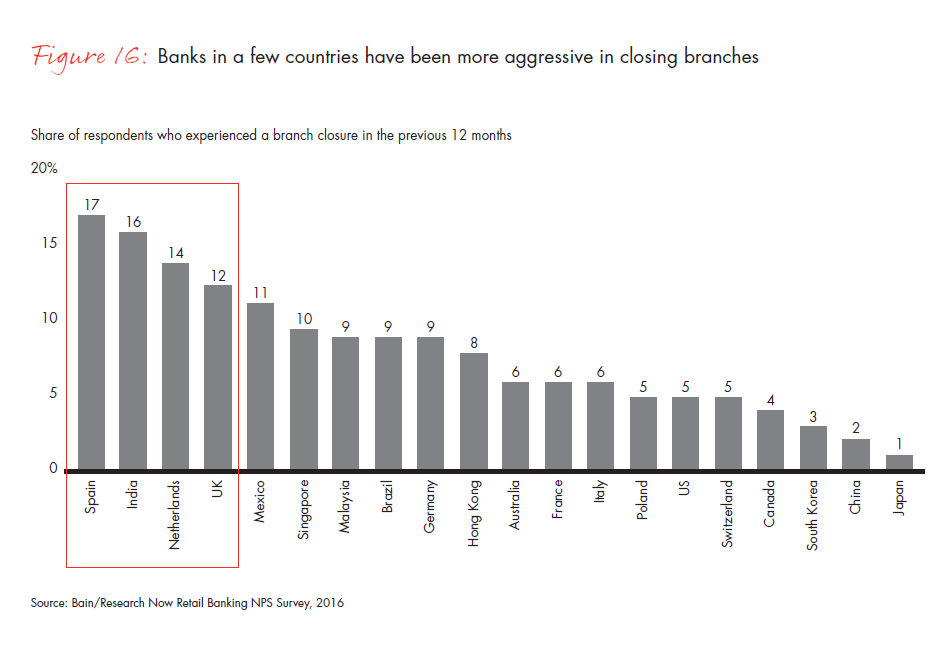
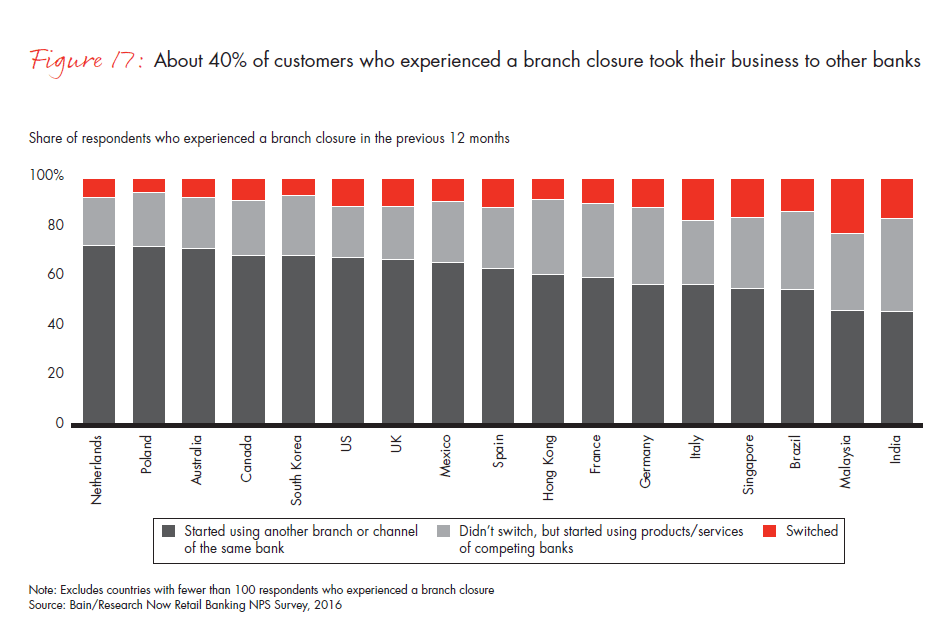
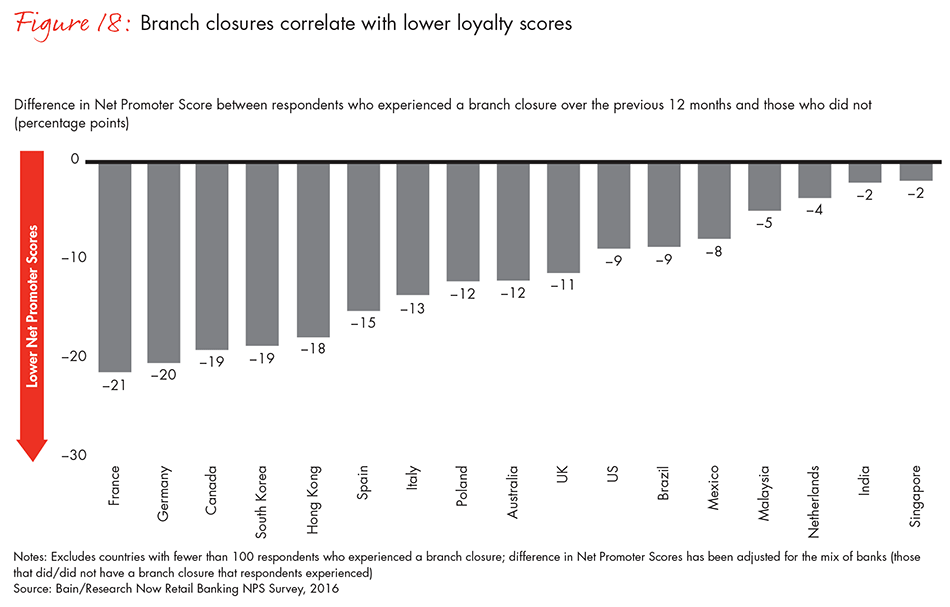
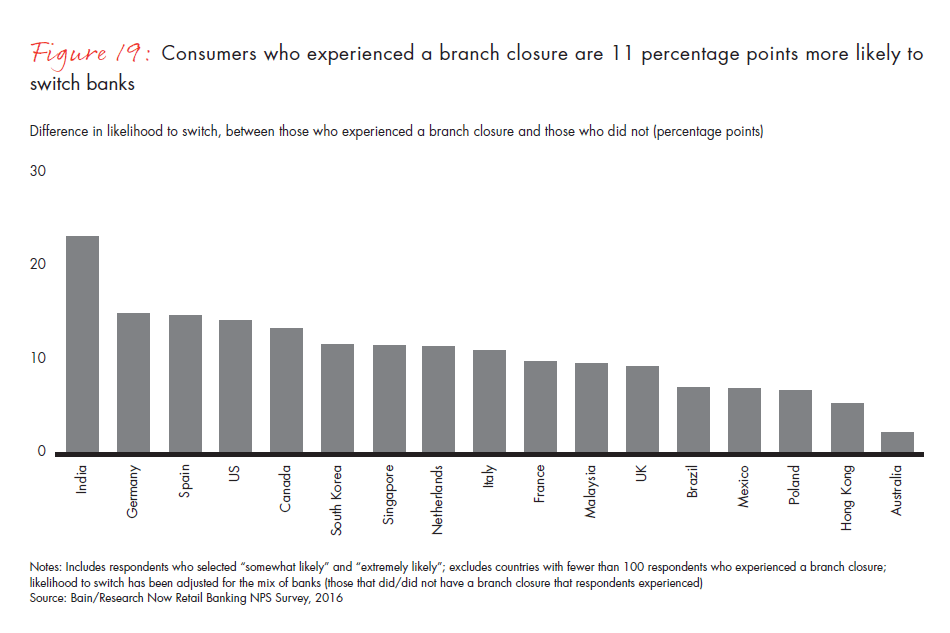
3. Hidden defection goes digital and siphons off value
- About one-third of consumers globally said they would be more likely to switch their primary bank if it were easier to do so, with India and Poland at the highest levels. Younger customers globally were even more likely to express a desire to switch. India, Malaysia and the UK had the largest switching gap between young and old consumers.
- Not only did many customers say they would switch, but hidden defection—the purchase of additional banking products outside the primary bank—is even more prevalent. China, Hong Kong and Malaysia had the highest rate of hidden defection. The proportion of people purchasing only from a competing bank was particularly high in the UK and US, at 22% and 20%, respectively.
- What are consumers buying? In every country except Spain, consumers bought more higher-value products such as loans at competing institutions, while primary banks everywhere tended to win new lower-value deposits or current-account purchases.
- Consumers used digital channels about 1.4 times as often for purchases at competing institutions than for those at primary banks. This digital gap was greatest in the US, Japan and Canada.
- Direct banks and fintechs took a substantial share of product purchases. The share reached 34% in the UK, 29% in Germany and France, and double digits in 16 of 19 countries.
- Greater loyalty improved the odds of cross-selling. Consumers who are promoters of their primary banks were far more likely than detractors to buy the next product from that bank.
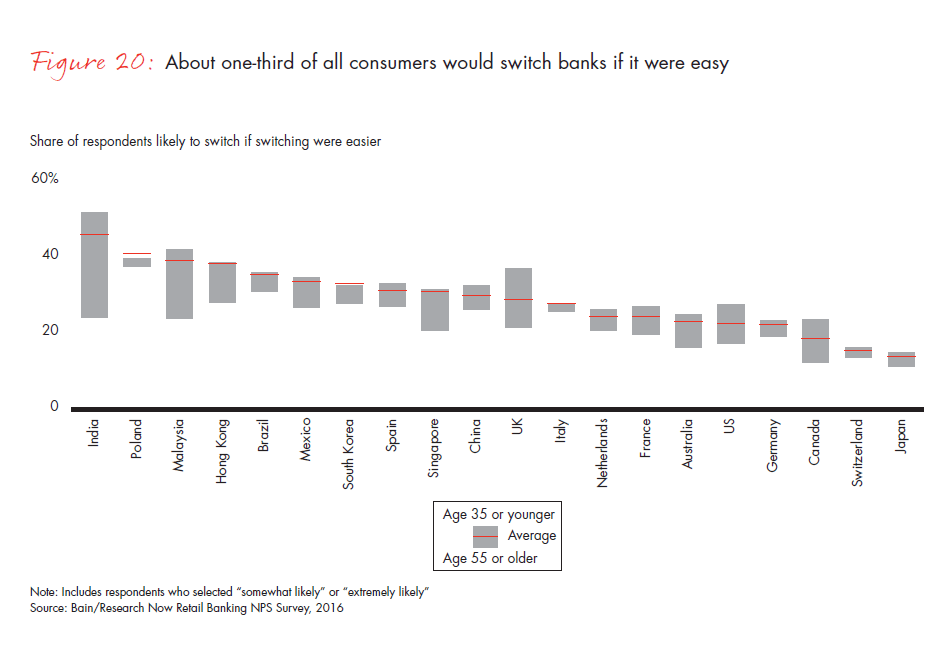
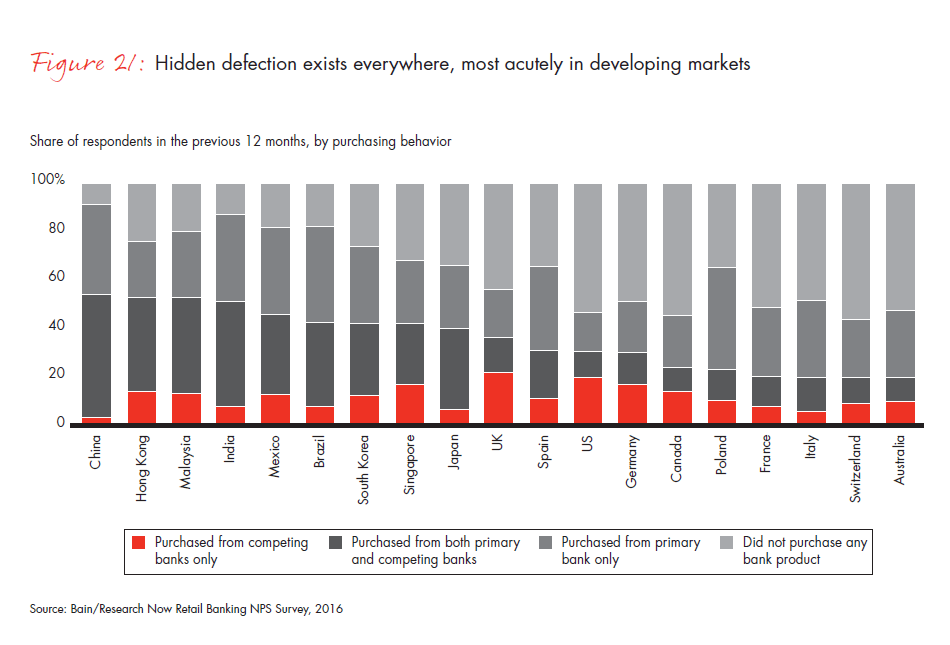
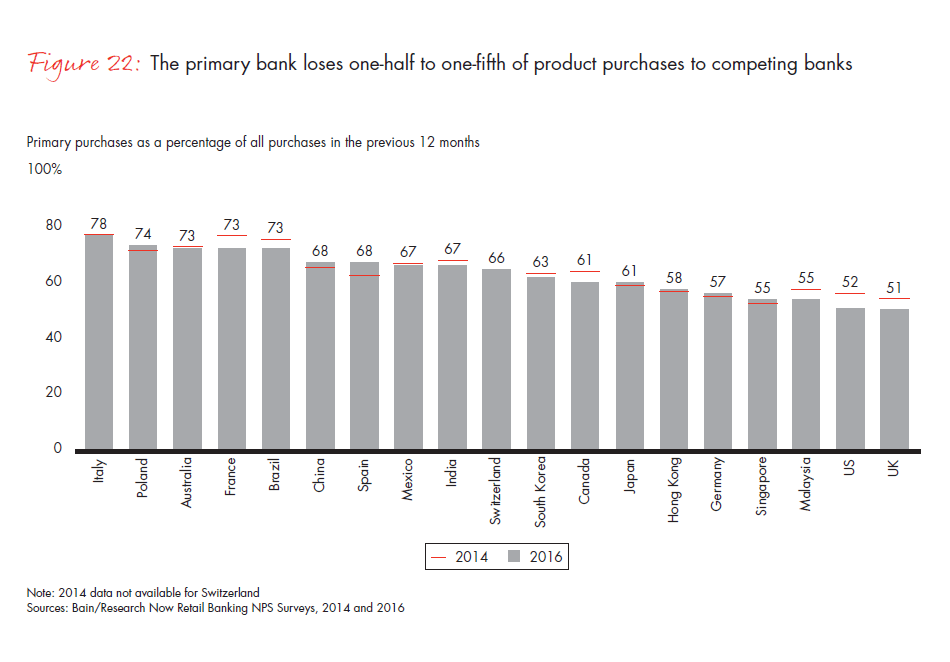
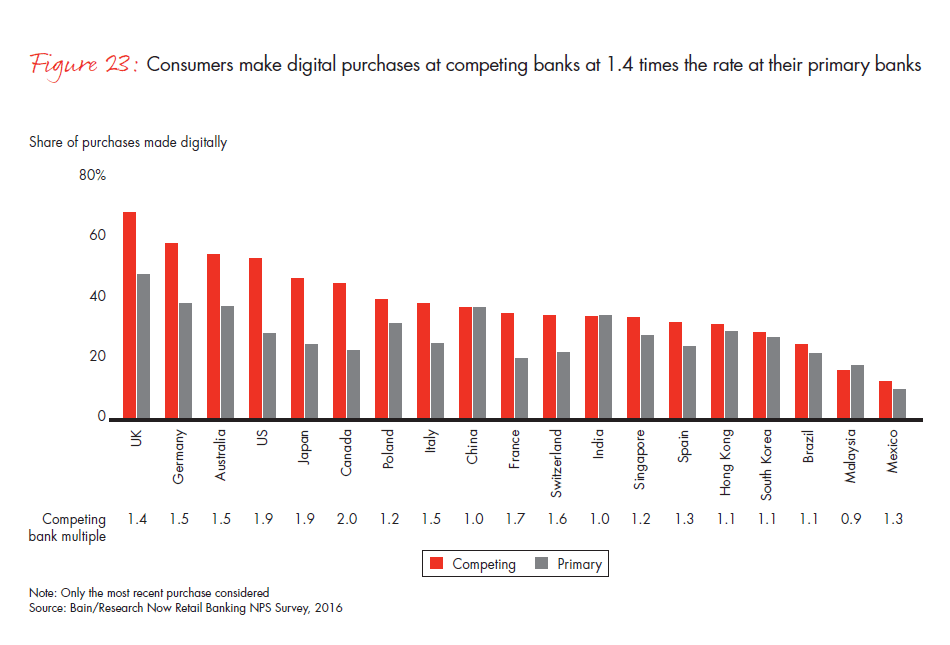
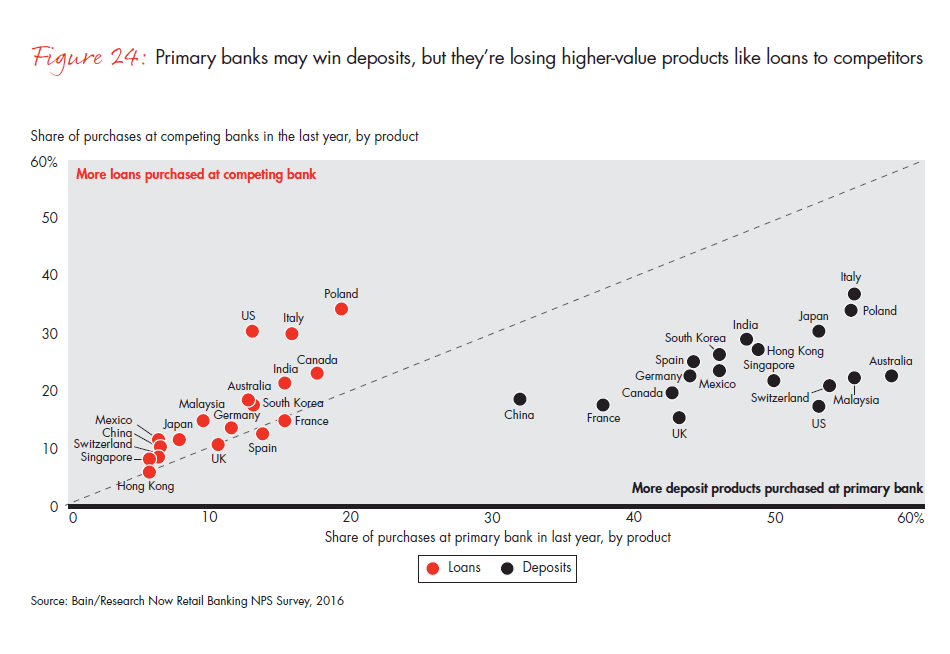
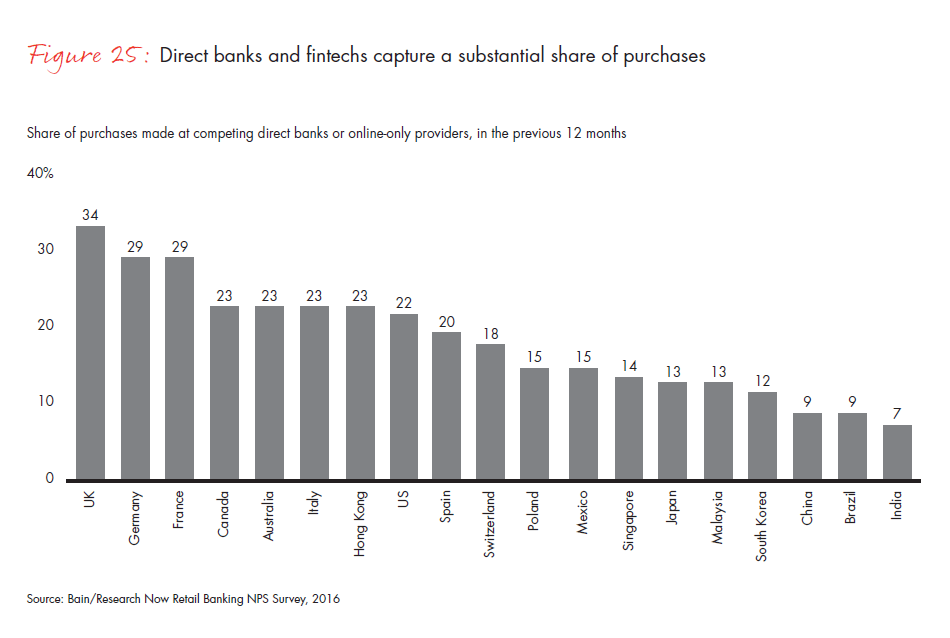
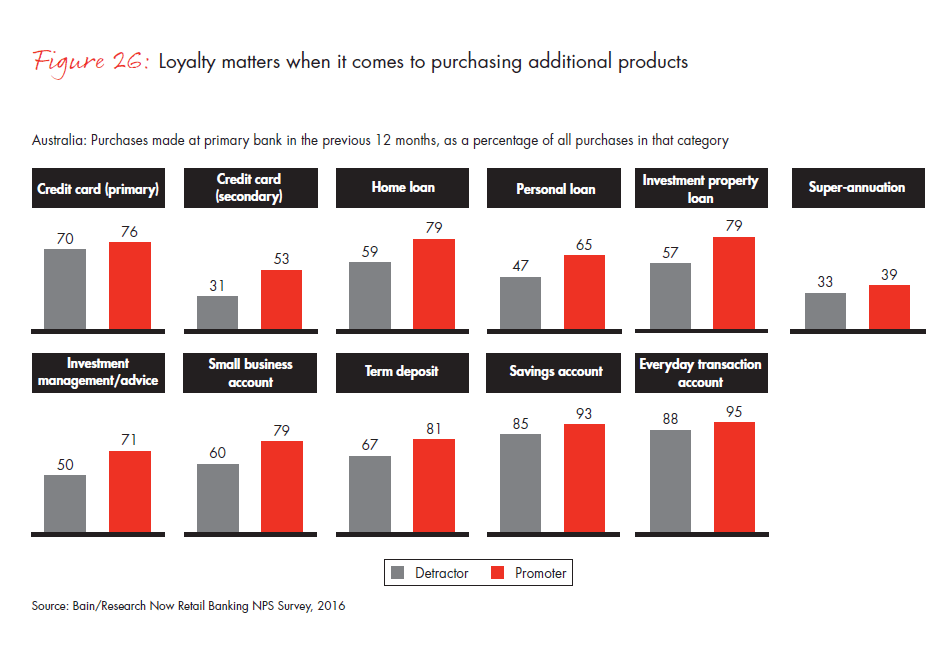
4. Movement on the loyalty leader boards
- Direct banks continue to lead in Net Promoter Scores relative to national, regional or smaller competitors. In a few markets such as the UK and Germany, large branch banks gained ground.
- Some big banks have demonstrated sustained progress over the past few years. In the UK, Santander has significantly improved its Net Promoter Score, rising to No. 2 among traditional banks in 2015 and further closing the gap with the leader this year. In Spain, BBVA moved up steadily to clinch the No. 2 position among traditional banks last year and has continued to narrow the loyalty gap.
- For an individual bank, what matters is how it performs against peers in its market. Using that lens, Net Promoter Scores varied widely from country to country. In Australia, for instance, the score of top performer ING Direct was 86 percentage points higher than the worst performer. In Hong Kong, loyalty leader HSBC outperformed the worst by just 12 percentage points.
- In-country differentials between the loyalty leader and the laggard were largest in the Northeast region of the US, Spain, Germany, Italy and the UK.
- Only a few banks have held the top spot year over year, including USAA in the US and First Direct in the UK.
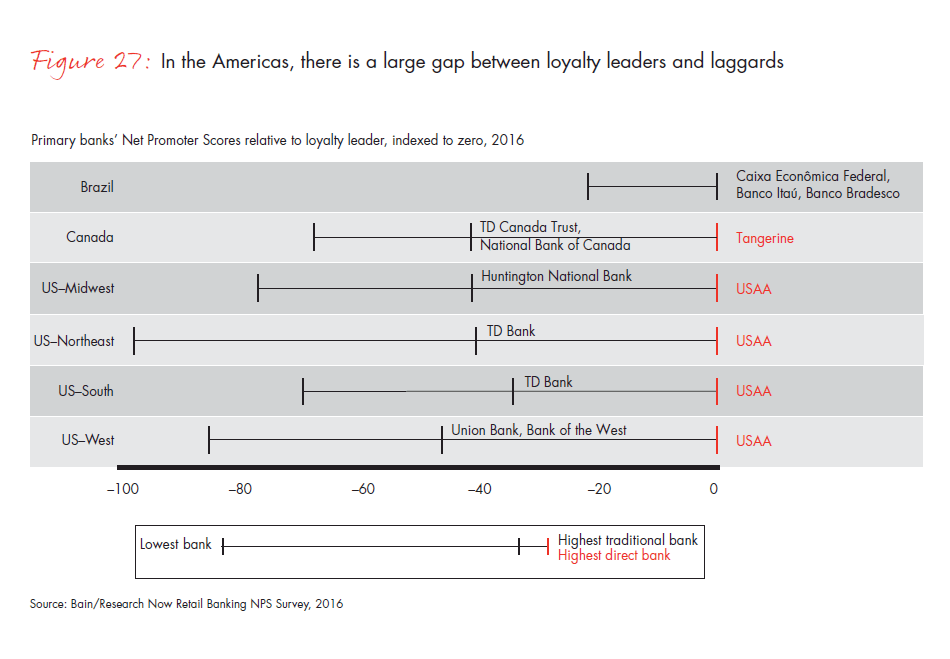
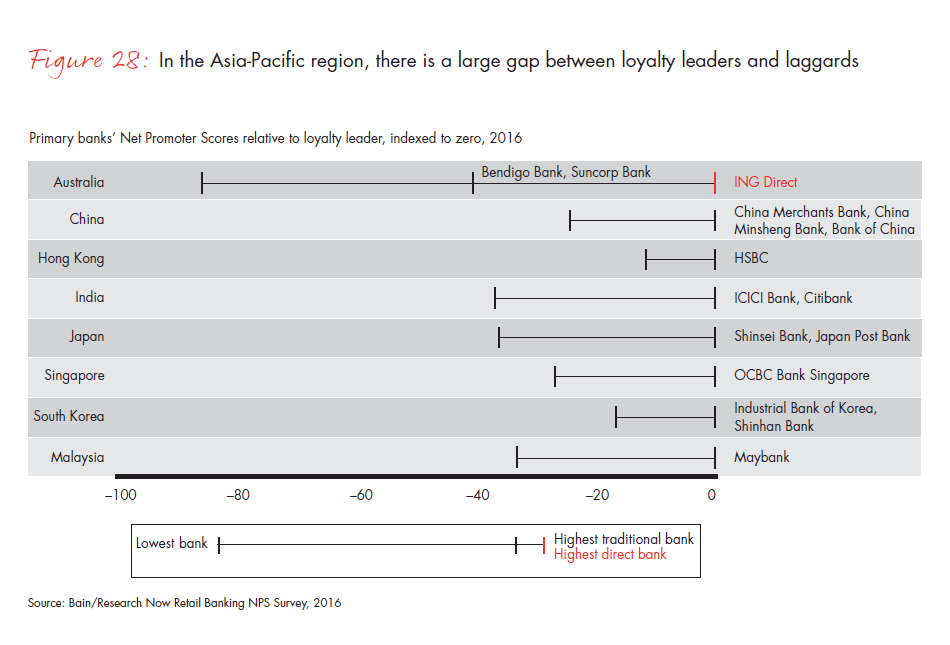
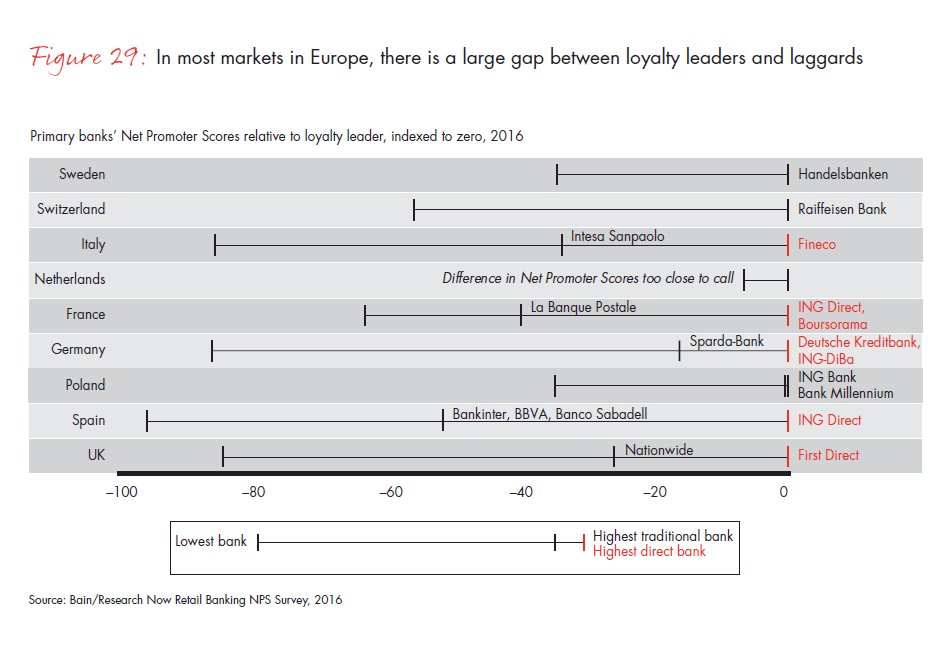
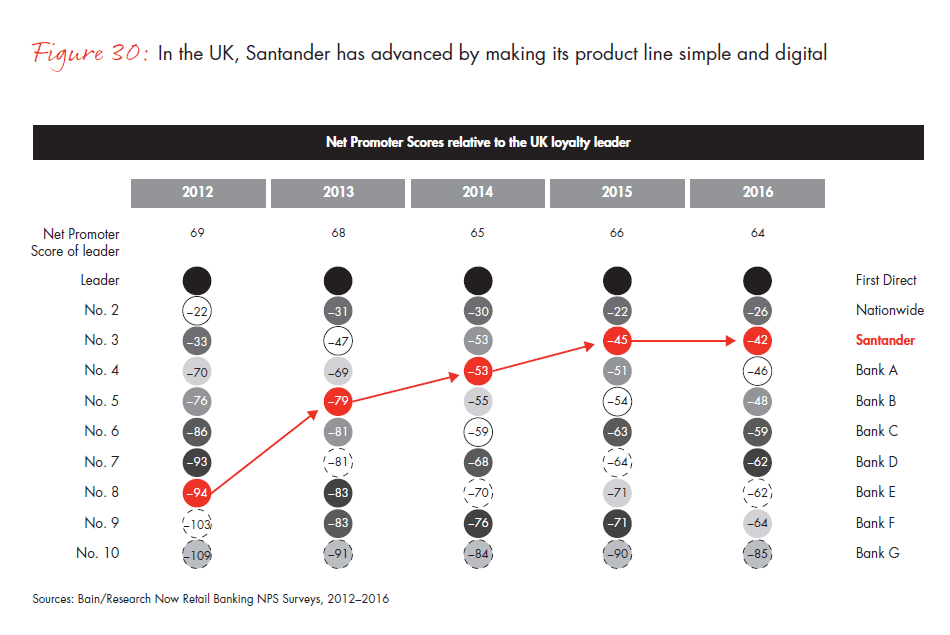
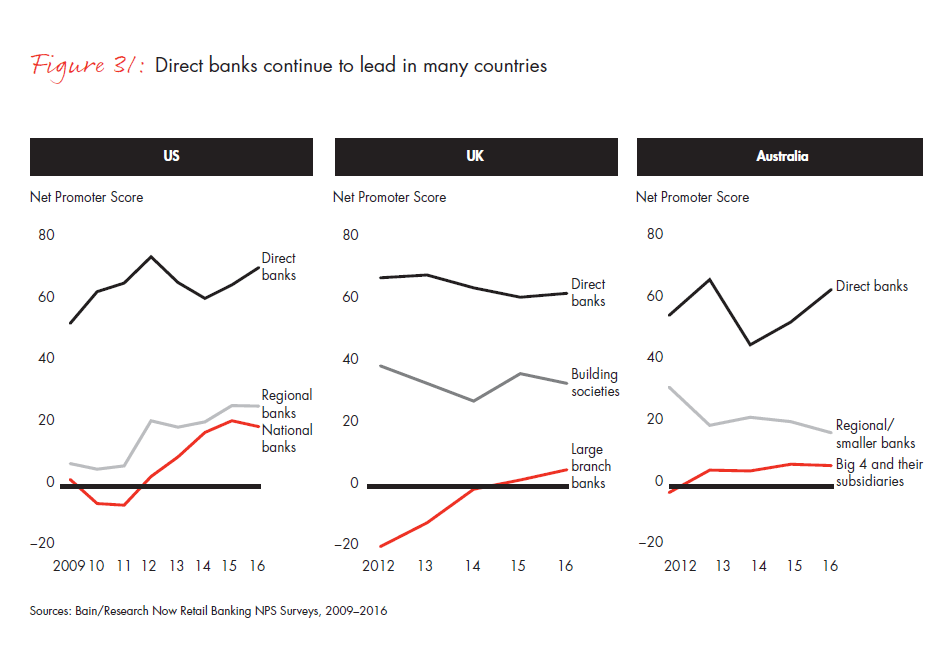
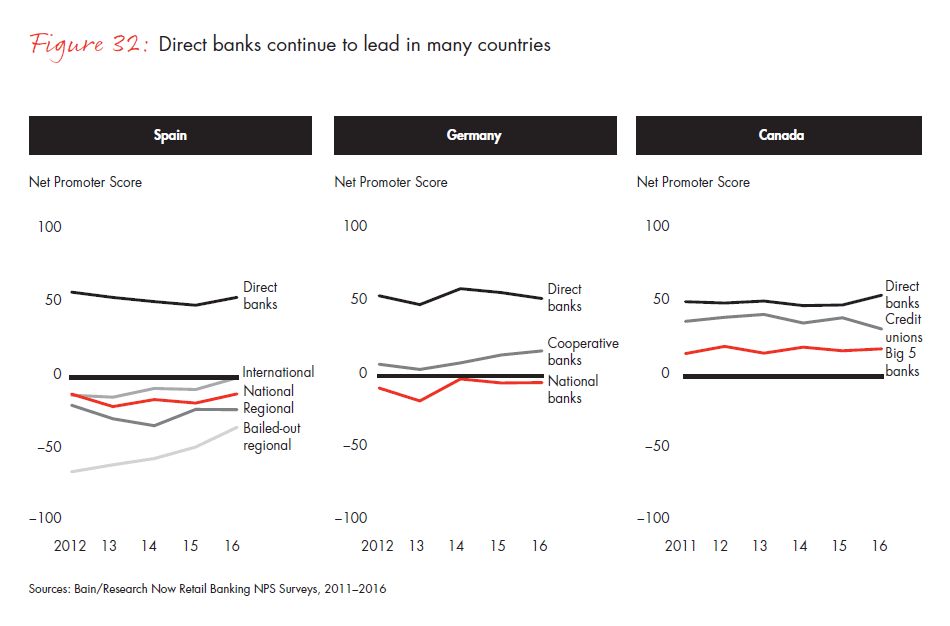
Appendix: Methodology
Bain & Company partnered with Research Now, an online global market research organization, to survey consumer panels in Australia, Brazil, Canada, China, France, Germany, Hong Kong, India, Italy, Japan, Malaysia, Mexico, the Netherlands, Poland, Singapore, South Korea, Spain, Sweden, Switzerland, the UK and the US. The survey’s purpose was to gauge customers’ loyalty to their principal bank and the underlying reasons customers hold their views. Conducted from July to September 2016, the survey polled 137,034 respondent consumers of national branch network banks, regional banks, private banks, direct banks, community banks and credit unions in these countries.
For individual bank analysis in the Americas and most countries in Europe, we included only banks for which we received at least 200 valid responses. In Switzerland and Asia, we included banks with at least 100 responses. In many instances, sample sizes exceeded these thresholds.
Survey questions
Respondents were first asked to identify their primary bank, then were asked the following questions to assess their loyalty to that institution:
- On a scale of zero to 10, where zero represents “not at all likely” and 10 represents “extremely likely,” how likely are you to recommend your primary bank to a friend or relative?
- Tell us why you gave your primary bank the score you did.
We asked what major products respondents hold with their primary bank and with other banks, and which of these products were purchased in the past year. We also asked respondents what their most recent purchase had been, and the channels they used to make this purchase. Further, we asked how often they interacted through various channels to do their banking in the past three months. We then questioned whether respondents experienced a closure of a bank branch that they used. If so, we asked how this closure affected their relationship with the bank, and if not, we asked their likelihood of switching their bank in the future. The remaining questions elicited demographic profile information: household income, investable assets and region of residence.
For statistical significance, the results of our data analysis are robust both for the measurement of bank Net Promoter Scores by country and for respondent Net Promoter Scores for each demographic category. For the Americas and most countries in Europe, the Net Promoter Scores measured for each bank in the country and US regional rankings are statistically significant to an 80% confidence level, with a two-tailed test of the confidence interval ranging from ±2% (n=868) to ±7.4% (n=228). In Switzerland and Asia, where sample sizes were smaller, confidence intervals are wider, with a maximum of ±10%.
This report was prepared by Gerard du Toit and Maureen Burns, partners in Bain’s Financial Services practice, and a team led by Christy de Gooyer, a practice area director. Team members are Karan Chhabra, Sourish Gue, Lakshay Kataria, Rachit Jain, Thiago Lamelo and Pranav Singh. The authors thank Bain partners in each of the countries covered in the report for their valuable input and John Campbell for his editorial support.
Net Promoter Score® is a registered trademark of Bain & Company, Inc., Fred Reichheld and Satmetrix Systems, Inc.































